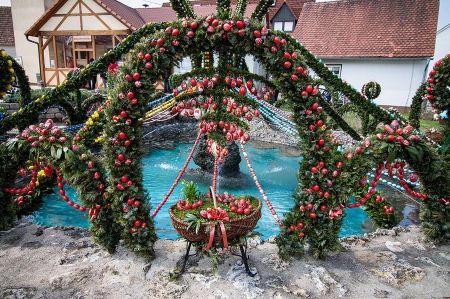The Easter fountain in the Steigerwald in Franconia
- Written by Portal Editor
Despite the never-ending winter in the Balkans, Austria and Germany, some important dates and planning made it necessary to start the journey from Antalya back to Kitzingen.
After a short stopover in Izmir, the journey continued via the Dardanelles towards Thessaloniki. On the way, the temperature fell from around 20° degrees in Macedonia to initially 12° degrees near Nis in Serbia to -2° degrees shortly before the Serbian capital Belgrade. There is also heavy snowfall here. Well, according to our thoughts, there could still be something on the rest of the trip. However, the day's stage was over in Belgrade and so we were excited about the next day.
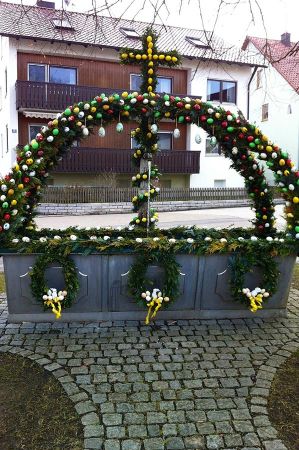 We set off early in the morning in order to cross Belgrade before the morning rush hour traffic if possible. The drifting snow had turned into light snow and the gritting services had done a good job on the former road route towards Zagreb. The entire route was very easy to drive. However, there was an oddity during this leg between Belgrade and Zagreb that made driving very unpleasant: birds on the road. Whether it was the winter hunger in search of food or even the mineral salt from the gritting services that caused the birds to repeatedly settle on the road in large flocks, it was terrible driving for all vehicle drivers because it was simply impossible to avoid them; Reducing the speed didn't help much either, because then many birds actually just stayed sitting on the road. So, it was not surprising that a number of the birds did not survive this behaviour due to the traffic. A number of birds of prey and corvids had already gathered at the side of the road to help themselves to the leftovers. We had never experienced such behaviour before, despite the fields being covered with little snow.
We set off early in the morning in order to cross Belgrade before the morning rush hour traffic if possible. The drifting snow had turned into light snow and the gritting services had done a good job on the former road route towards Zagreb. The entire route was very easy to drive. However, there was an oddity during this leg between Belgrade and Zagreb that made driving very unpleasant: birds on the road. Whether it was the winter hunger in search of food or even the mineral salt from the gritting services that caused the birds to repeatedly settle on the road in large flocks, it was terrible driving for all vehicle drivers because it was simply impossible to avoid them; Reducing the speed didn't help much either, because then many birds actually just stayed sitting on the road. So, it was not surprising that a number of the birds did not survive this behaviour due to the traffic. A number of birds of prey and corvids had already gathered at the side of the road to help themselves to the leftovers. We had never experienced such behaviour before, despite the fields being covered with little snow.
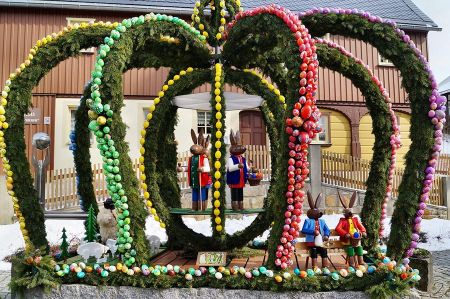 From Zagreb we went via Maribor, Graz, Linz, Passau and Nuremberg to our branch office in Kitzingen. After the first review of the correspondence we had received, we met Brita, who had invited us to dinner. She reported on the events of the last few weeks on site, on the upcoming celebrations on the occasion of the upcoming Easter and then talked about some of the related special features of the local region. We listened to their explanations with great interest, especially since we had never heard of the “Franconian Easter fountains” before, let alone seen them.
From Zagreb we went via Maribor, Graz, Linz, Passau and Nuremberg to our branch office in Kitzingen. After the first review of the correspondence we had received, we met Brita, who had invited us to dinner. She reported on the events of the last few weeks on site, on the upcoming celebrations on the occasion of the upcoming Easter and then talked about some of the related special features of the local region. We listened to their explanations with great interest, especially since we had never heard of the “Franconian Easter fountains” before, let alone seen them.
The custom of decorating public fountains in villages and towns at Easter time is said to have originally come from Franconian Switzerland. This custom has now spread across large parts of Franconia. Shortly before or during Good Friday, the village fountains are decorated with garlands made of fir green, which are often tied into crowns and decorated with many colourful Easter eggs. Consisting mostly of blown out real eggs, which were then painted by hand, this fountain decoration offers a wonderful play of colours in the otherwise rather grey surroundings of the slowly receding winter.
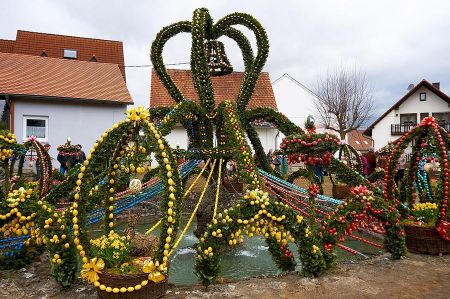 Scholars debate where and why this custom arose. According to some oral traditions, the first decorated Easter fountain was supposedly seen in Aufseß around 1909. It is still debatable whether there were primarily religious reasons for decorating the public fountain or whether the aim was to address the water shortage that often existed in Franconian Switzerland by giving the fountain special attention. Some people also claim that this ceremonial decoration after the wells and springs were cleaned because the winter had passed played an important role in giving greater importance to the importance of water supply. Others, on the other hand, claim that the celebrations are supposed to be about existing, once Slavic and therefore pagan customs. Even Nazi propaganda tried to use the decorated Easter fountains for their own purposes and interpreted this custom as a “Germanic custom” with ancient roots as a source cult. With the fall of the Nazi regime, the custom of decorating the Easter fountains also declined sharply, until in 1952 the Nuremberg doctor and castle researcher Dr. Kunstmann took on this topic. Together with his wife, he made a significant contribution to the renewed spread of decorating the village fountains into the so-called Easter fountain.
Scholars debate where and why this custom arose. According to some oral traditions, the first decorated Easter fountain was supposedly seen in Aufseß around 1909. It is still debatable whether there were primarily religious reasons for decorating the public fountain or whether the aim was to address the water shortage that often existed in Franconian Switzerland by giving the fountain special attention. Some people also claim that this ceremonial decoration after the wells and springs were cleaned because the winter had passed played an important role in giving greater importance to the importance of water supply. Others, on the other hand, claim that the celebrations are supposed to be about existing, once Slavic and therefore pagan customs. Even Nazi propaganda tried to use the decorated Easter fountains for their own purposes and interpreted this custom as a “Germanic custom” with ancient roots as a source cult. With the fall of the Nazi regime, the custom of decorating the Easter fountains also declined sharply, until in 1952 the Nuremberg doctor and castle researcher Dr. Kunstmann took on this topic. Together with his wife, he made a significant contribution to the renewed spread of decorating the village fountains into the so-called Easter fountain.
The Franconian Easter fountains
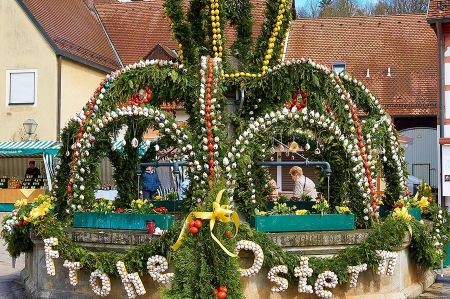 Wherever the origins of this custom can be seen, this idea has now spread greatly again in Upper Franconia and, in some communities, contributes heavily to the economic boom through local tourism as a source of income. Easter tours are now being undertaken from some large cities such as Munich and Dresden, which lead to the most lavishly decorated Easter fountains in Franconian Switzerland. Two places deserve special mention here because they are among the main destinations of this excursion tourism: Heiligenstadt and Bieberbach. The town of Heiligenstadt is sometimes served by up to 80 buses a day, setting a record number of visitors. In 2001, Bieberbach was even able to record a record entry in the Guinness Book of Records due to the almost unimaginable number of 11,108 hand-painted, blown-out real Easter eggs.
Wherever the origins of this custom can be seen, this idea has now spread greatly again in Upper Franconia and, in some communities, contributes heavily to the economic boom through local tourism as a source of income. Easter tours are now being undertaken from some large cities such as Munich and Dresden, which lead to the most lavishly decorated Easter fountains in Franconian Switzerland. Two places deserve special mention here because they are among the main destinations of this excursion tourism: Heiligenstadt and Bieberbach. The town of Heiligenstadt is sometimes served by up to 80 buses a day, setting a record number of visitors. In 2001, Bieberbach was even able to record a record entry in the Guinness Book of Records due to the almost unimaginable number of 11,108 hand-painted, blown-out real Easter eggs.
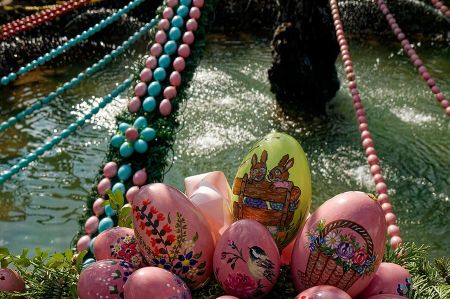 However, this custom has now also spread to the greater Bamberg area, the Steigerwald, Altmühlfranken, Saxony, the Palatinate and even Saarland. In 2005, the town fountain in Sulzbach-Rosenberg in Upper Palatinate was decorated with 16,500 eggs, achieving a new Guinness Book entry as a record. With the recognition of the positive impact on tourism, the tradition of Easter fountains also began in Haselünne in Emsland. Unfortunately, this custom has also attracted some jealous or destructive people who use the partly hand-painted, blown-out eggshells to throw. As a result, in many places the artistically painted chicken eggs were replaced by plastic eggs.
However, this custom has now also spread to the greater Bamberg area, the Steigerwald, Altmühlfranken, Saxony, the Palatinate and even Saarland. In 2005, the town fountain in Sulzbach-Rosenberg in Upper Palatinate was decorated with 16,500 eggs, achieving a new Guinness Book entry as a record. With the recognition of the positive impact on tourism, the tradition of Easter fountains also began in Haselünne in Emsland. Unfortunately, this custom has also attracted some jealous or destructive people who use the partly hand-painted, blown-out eggshells to throw. As a result, in many places the artistically painted chicken eggs were replaced by plastic eggs.
 We use the morning of the following Good Friday for a short tour through Franconia to look at some of these fountains in the village communities. And there was actually a wide range of different Easter fountains that we encountered on the route via Kaltensondheim, Feuerbach, Füttersee, Ebersbrunn, Biebelried, Kleinlangheim, Schlüsselfeld, Prühl, Westheim and Wiesentheid. In some cases, not only were the fountains decorated with pine greenery and Easter eggs, but other Easter figures were also added to the ensemble, creating a colorful Easter picture.
We use the morning of the following Good Friday for a short tour through Franconia to look at some of these fountains in the village communities. And there was actually a wide range of different Easter fountains that we encountered on the route via Kaltensondheim, Feuerbach, Füttersee, Ebersbrunn, Biebelried, Kleinlangheim, Schlüsselfeld, Prühl, Westheim and Wiesentheid. In some cases, not only were the fountains decorated with pine greenery and Easter eggs, but other Easter figures were also added to the ensemble, creating a colorful Easter picture.
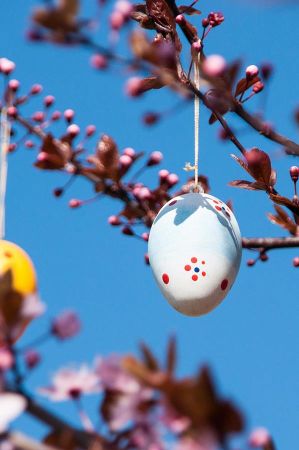 We were just about to take some photos at the Easter fountain in Kleinlangheim when a passer-by approached us and pointed out some details of the fountain, which she had also helped design. She was able to point out some of the blow-out and then hand-painted chicken eggs that were made by her niece years ago when she was in kindergarten. Each year these eggshells are carefully packaged and saved so that they can be displayed again the following year. Of course, new motifs are added every year and are made in local schools or kindergartens at Easter time. A beautiful custom that brings a little more color and light into the still dull everyday mood.
We were just about to take some photos at the Easter fountain in Kleinlangheim when a passer-by approached us and pointed out some details of the fountain, which she had also helped design. She was able to point out some of the blow-out and then hand-painted chicken eggs that were made by her niece years ago when she was in kindergarten. Each year these eggshells are carefully packaged and saved so that they can be displayed again the following year. Of course, new motifs are added every year and are made in local schools or kindergartens at Easter time. A beautiful custom that brings a little more color and light into the still dull everyday mood.
We wish you, dear readers, a happy Easter. Use the time to perhaps rediscover local activities. And there is appropriate clothing for cold, unfriendly weather available.
Please read as well:
George McGavin – früher Entomologe der Universität Oxford
Amazonia in the Panometer of Dresden – Yadegar Asisi
https://www.alaturka.info/en/germany/bavaria/6514-the-easter-fountain-in-the-steigerwald-in-franconia#sigProIdeae0fab8c0
